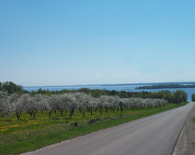The Pileus Project at Michigan State University
Assessing climate impacts for two major Michigan industries
For those who rely on weather and climate as part of their economic livelihood, the Pileus Project at Michigan State University provides useful climate information to assist decision making.

The Pileus Project at Michigan State University
MSU researchers are working with two major Michigan industries, tourism and agriculture, to better understand how to assist economic decision making by incorporating information on past, present, and potential future climate. Climate variability and change have far reaching implications for Michigan's tourism industry, impacting ski resorts, golf courses, and other outdoor recreational economies. And, Michigan farmers lead the nation in tart cherry production, a crop that is vulnerable, sometimes dramatically, to Great Lakes weather.
The Pileus Project is addressing these impacts in a form that is operationally useful. The project aims to assist crop growers and processors, lenders, educators, and researchers by pooling stakeholder experiences, expertise, and knowledge. The research team is led by co-directors Jeffrey Andresen, associate professor in MSU's Department of Geography and State of Michigan Climatologist, and Julie Winkler, professor in MSU's Department of Geography.
Learning from Climate History in the Great Lakes Region
Project leaders posed a fundamental question about climate history: "What are some notable climate trends in the Great Lakes region, and how have past climate changes impacted regional agriculture and tourism?"
Potential weather/climate impacts were identified from published research in the scientific literature and from people working within the agriculture and tourism industries. These results were used in the definition and development of new variables that best capture and illustrate the impact of climate variability on the industries—tart cherry production, grain quality (specifically, corn), golf, and downhill skiing and snowboarding.
"Ski resort owners are interested in snowfall, but they are also interested in what happens after a snowfall. How long the snow will be there? Factor in the weight of the snow, its water content, and how much sunshine is available, and you begin to see how complicated it is to make decisions about how much new snow to generate to keep the resort in operation," said Andresen. "SkiTool is one resource that we developed to explore how different snow making strategies can work best now and in the future."
The team compiled historical climate data from 18 locations in the Great Lakes region, including maximum, minimum, and average daily temperatures; liquid-equivalent precipitation; frozen precipitation; and heat index and wind chill, into a user-friendly web tool.
Forecasting Future Climate Changes
At the core of most climate change impact studies are one or more scenarios that describe potential future climate conditions, so the following question was posed: "How might the climate of the Great Lakes region change in the future, and what are the implications for agriculture and tourism?"
"Michigan's tart cherry industry relies on certain weather conditions for success. Climate variability affects cherry tree phenology, economic cost of production, net returns over time, and even the need for insurance," said Andresen. "The general method used in this study is an end-to-end assessment strategy. Historical time series and projected future climate scenarios are sequentially linked to phonological, economic, and decision-making models."
For the models developed as part of the Pileus Project, climate scenarios at the local spatial scale and daily temporal scale are required. The team developed daily temperature and precipitation scenarios for 15 locations in the Great Lakes region.
"One of our goals is transparency—striving to communicate to users the methods used to develop the scenarios and the uncertainty surrounding the scenarios," said Winkler.
About the Pileus Project
The Pileus Project was named after the pileus cloud, which appears as a cap at the top of the cumulonimbus cloud. The name was chosen to symbolize the "capstone" or overarching nature of the project. The Pileus Project strives to provide a better understanding of historical climate trends, variability, and past impacts on people and industry; evaluate how future climate trends and variability may impact people and industry, using newly developed, climate-related models; and create an economic framework, that explicitly incorporates climate into the decision-making process. Visit the Pileus Project Web site for more information.
- Written by Carla Hills, University Outreach and Engagement